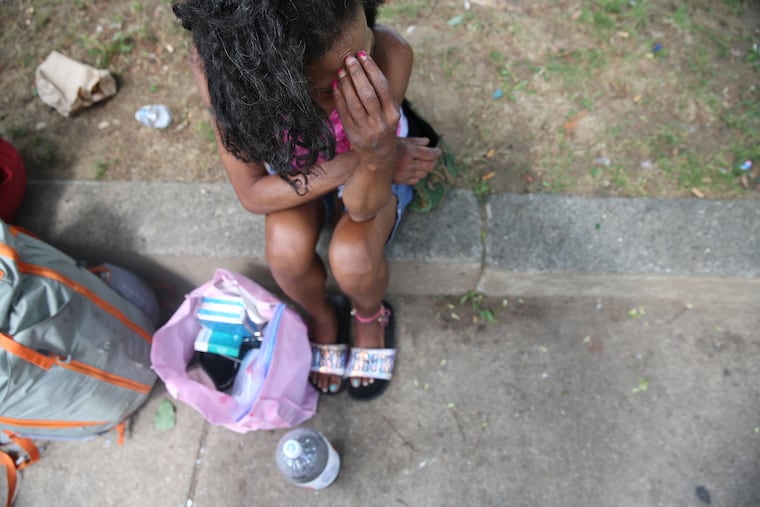Drug overdose toll rises in Philadelphia as heroin prized for ‘purity’ turns out to be contaminated
The weekend's overdose cluster drove home a fact that advocates, law enforcement officials, and drug users have known for months: Philadelphia's heroin supply, long noted for its purity and cheapness, is almost entirely contaminated.

In a Philadelphia park Friday night, Rachel Freeman watched as a half-dozen people slid into overdoses, a shocking display even for the drug-torn Kensington neighborhood.
But as paramedics revived them, they began to scream and shake — much different from a typical overdose reaction. "It was almost like being in a horror movie," Freeman said.
Nonetheless, Freeman, a slight 50-year-old with brightly painted fingernails who is known as "Mom" by drug users in the community, prepared her own bag of heroin later that night. She felt safer using a bag stamped "Santa Muerte" (literally, "Holy Death"), a variety reputed to be some of the last pure heroin available in the city, uncontaminated by fentanyl or other adulterants.
Freeman didn't realize that Santa Muerte was what everyone else in the park had bought, too. She woke up at Temple University Hospital after overdosing.
On Friday and Saturday, at least 165 people around the city overdosed — an unprecedented number, health officials said, and thought to have been driven by the type of drug Freeman bought. Health officials believe it may have been heroin cut with an anticholinergic, a substance found in muscle relaxers and the antihistamine diphenhydramine (Benadryl) that causes dangerous side effects.
Yet the death toll — 10 people — is about the typical number of overdose deaths on a given weekend in a city where 1,217 people died of an overdose in 2017.
Still, the cluster tested the city's response to overdoses and drove home a fact that advocates, law enforcement officials, and drug users have known for months: Philadelphia's heroin supply, long noted for its purity and cheapness, is almost entirely contaminated, largely with the synthetic opioid fentanyl and sometimes with other substances.
Thomas Farley, the city health commissioner, said over the weekend that the alarming incidents are still more proof that the city needs to open a safe injection site, a controlled setting where people can get help more quickly.
The health department said police first reported six overdoses within about 15 minutes Friday at the intersection of Kensington and Allegheny Avenues. Outreach workers from the health department and community organizations were dispatched to the neighborhood and, along with paramedics, responded to several overdoses themselves.
On Tuesday, health officials were awaiting testing of bags found in the hands of overdose victims over the weekend. The drug that health officials fear was behind last weekend's rash, stamped with "Santa Muerte," has been specifically sought out by longtime heroin users like Freeman who fear overdosing on fentanyl.
Though many people think of illicit opioid use as a fast route to death, there are people who use heroin for many years without overdosing — as long as they know that pure heroin is what they are using.
Some more recent arrivals in Kensington, however, say they actually prefer the deadlier synthetic opioid fentanyl. "There's no one doing heroin," claimed a young man sitting in a folding chair at the Frankford Avenue heroin encampment Sunday morning. "You'll be doing six bags of heroin [for the effect of] one bag of fentanyl."
But fentanyl's effects are impossible to predict, especially when taken unintentionally. The synthetic was present in 84 percent of all opioid-related deaths in Philadelphia last year.
"There's a lot of people who started using injection drugs years ago, and only do heroin," said Patrick Trainor, a spokesperson for the Drug Enforcement Agency. "But they have to take something to avoid getting sick [with painful withdrawal symptoms], and then it's so much more risky — because with the drug [samples] we see, we barely see heroin anymore. It's all fentanyl."
At Prevention Point, the needle exchange near McPherson Square, staffers hand out fentanyl testing strips along with the overdose reversal medication naloxone, said Jose Benitez, the exchange's director.
"We're telling people to assume that everything is contaminated," he said.
Freeman, who has used heroin on and off for about 25 years, and other older heroin users said the rise of fentanyl is frightening.
"You're just taking a chance," said a woman named Gabby in the Emerald Street heroin camp. "The fentanyl is getting out of hand. They're playing with people's lives."
Gabby said she had overdosed twice in one day on a bag of fentanyl a month ago, and has since entered a medication-assisted treatment program. She, too, used to seek out Santa Muerte for its relative purity. But she tried to take precautions when using: watching to see how others reacted to heroin bearing the same stamp that she had just bought, or trying to inject slowly.
By Tuesday, the situation was mostly back to normal in Kensington — which, health officials said, means 35 overdoses in city emergency rooms a day. On Monday, a group of people lined up a few blocks off Kensington Avenue as a dealer handed out free samples of heroin. In McPherson Square, a woman overdosed next to a park bench outside the library.
After an Inquirer columnist, a library staffer, and paramedics revived her, she walked away. A woman named Tricia ran after her to find out what she had been using. Sometimes drug users flock to products linked to more overdoses, figuring they have the built-up tolerance to handle them. Not this time. Tricia said she wanted to avoid the product — and an overdose.
Reporter Aubrey Whelan and columnist Mike Newall saw the woman who was overdosing outside the library collapse. While Newall administered naloxone (which both journalists regularly carry), Whelan called 911 and ran to the library for assistance. A library staffer brought a second dose, helping the woman to breathe, and then paramedics administered oxygen, reviving her.